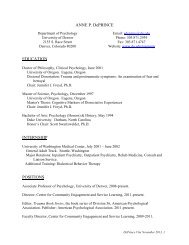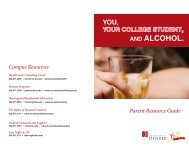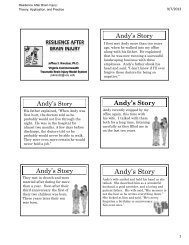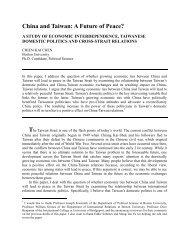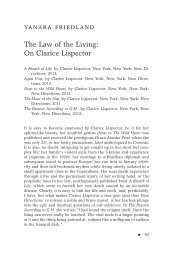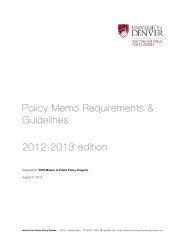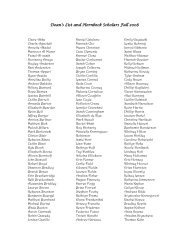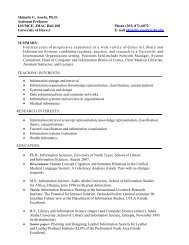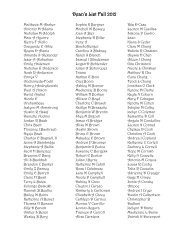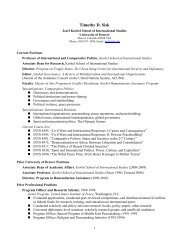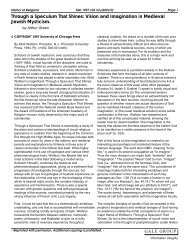Create successful ePaper yourself
Turn your PDF publications into a flip-book with our unique Google optimized e-Paper software.
Associate Pr<strong>of</strong>essor Julie Laser at the<br />
Summer Palace in Beijing<br />
Ann Howie<br />
(standing in<br />
doorway at<br />
rear) with<br />
health care<br />
workers in<br />
Santiago,<br />
Chilé.<br />
Howie (right) at Japan’s<br />
Miyagi Prefecture South Nursery<br />
18 spring 12 where in the world is <strong>GSSW</strong>?<br />
Research and Teaching in China<br />
by Associate Pr<strong>of</strong>essor Julie Laser, PhD<br />
During my nine years at <strong>GSSW</strong>, I have worked on two distinct, but interrelated,<br />
projects in China. The first is a collaborative study <strong>of</strong> everyday resilience among<br />
Chinese youth, similar to research I previously conducted in Japan, Korea, Senegal<br />
and the United States. I also created and led an MSW course focused on social work<br />
in China. Both projects continue a research and academic collaboration between<br />
<strong>GSSW</strong> and Beijing’s China Youth <strong>University</strong> that began more than 18 years ago.<br />
Everyday Resilience in Youth Projects<br />
My Everyday Resilience in Youth (ERY) projects investigate the concept <strong>of</strong><br />
resilience, by culture and gender, by researching the factors that protect or<br />
promote healthy development for youth, as well as the risk factors that are<br />
particularly deleterious to youth. To best understand these protective and risk<br />
factors for youth from each country, it is imperative that those<br />
who know youth best are partners in the research process.<br />
Therefore, my ERY projects are conducted in collaboration with<br />
youth experts in each host country.<br />
Researchers from the United States, Canada, Europe, Australia<br />
and New Zealand have found a great deal <strong>of</strong> commonality in<br />
terms <strong>of</strong> protective factors and risk factors for youth. Yet, until<br />
recently, virtually nothing has been known about resilience from<br />
a “non-western” perspective.<br />
I have created the two base survey instruments that the ERY<br />
projects use. The Laser Ecological Protective Factors for Youth-<br />
Revised (LEPFY-R) is designed to assess potential protective<br />
factors and has 151 items, with responses provided on a fivepoint<br />
Likert scale. Questions include internal, family, peer,<br />
neighborhood and school protective factors that a youth may<br />
possess or have in her or his environment. The 114-item Life<br />
Events Survey <strong>of</strong> Youth-Revised (LESY-R) measures potential risk<br />
factors in the youth’s development, family, peer, neighborhood,<br />
school and media influences. Responses also are given on a five-point Likert scale.<br />
Both instruments are modified by knowledgeable people in the countries where the<br />
research is being conducted. The instruments, with culturally appropriate modifications,<br />
have been used by over 3,500 respondents in Ghana, Japan, China, Korea, Senegal and<br />
the United States. Both instruments have good reliability and validity. As part <strong>of</strong> the data<br />
analysis, male and female sub-samples are evaluated.<br />
Over time, having a base survey instrument that remains constant enables me to study<br />
resilience across cultures, by region and by gender. Modifying the instruments slightly<br />
in each culture allows me to better understand resilience in each specific country. This<br />
combination allows me to better understand both universal risk and protective factors<br />
and those that are most pertinent to a particular culture, region and gender.<br />
Everyday Resilience in Chinese Youth<br />
An investigation <strong>of</strong> youth resiliency in China has never been undertaken and is a<br />
fascinating new exploration into the mechanisms <strong>of</strong> protective and risk factors.<br />
Conducted in collaboration with Dr. Li Yan Ping at the China Youth<br />
<strong>University</strong> in Beijing, this study is a continuation <strong>of</strong> a collaborative<br />
relationship with <strong>GSSW</strong> that began in 1994.<br />
The sample consisted <strong>of</strong> 1,292 youth attending post-secondary schools<br />
in the Beijing area. The schools differed in prestige and academic focus;<br />
along with two vocational schools, there were two-year colleges, fouryear<br />
colleges and four-year universities. We evaluated the risk factors<br />
that contributed to outcomes <strong>of</strong> delinquency, internalizing behavior,<br />
substance abuse and sexual acting out, as well as protective factors<br />
that increased the likelihood <strong>of</strong> resiliency.<br />
Social Work from a Chinese Perspective<br />
Social work strives to understand the person in the environment.<br />
Similarly, as environments vary, so does social work practice.<br />
“Social Work from a Chinese Perspective,” the MSW course I<br />
developed and taught for the first time in 2006, provided students<br />
with an opportunity to learn in the classroom about China’s social,<br />
cultural, historical, political and economic characteristics, then<br />
see firsthand how these characteristics have made Chinese social<br />
work distinctive.<br />
In Beijing, students attended lectures given by faculty at China<br />
Youth <strong>University</strong> (CYU), participated in discussions with social<br />
work students, visited social work organizations and important<br />
cultural landmarks, and took part in a nightly synthesis <strong>of</strong> their<br />
new knowledge and experiences.<br />
After five years <strong>of</strong> teaching this course, I conducted a survey to<br />
determine its long-term outcomes. The survey focused on my<br />
former students’ knowledge about China, as well as how the<br />
course has influenced their personal growth, world outlook and<br />
development as social workers.<br />
The survey results were very encouraging. Eighty-five percent<br />
<strong>of</strong> the former students believed the course helped them better<br />
understand others, and 80 percent said they gained better insight<br />
into themselves. All <strong>of</strong> those surveyed believed the course<br />
increased their international awareness, nearly 90 percent said<br />
it changed their world-view, and more than 60 percent said it<br />
changed the way they understand their own nationality, as well<br />
as their level <strong>of</strong> responsibility as Americans and world citizens.<br />
Ninety-two percent <strong>of</strong> the students believed the course helped<br />
them become better social workers, and nearly three-quarters<br />
said their approach to social work was different because <strong>of</strong> their<br />
participation in the China program.<br />
As these survey results clearly illustrate, well-organized international<br />
experiences can greatly enhance social work education, deepen<br />
and sustain students’ commitment to social justice, and have an<br />
enduring effect on their future social work practice.<br />
Where in theWorld is <strong>GSSW</strong>?<br />
cHina | Japan | cHilé<br />
Taking Animal-Assisted<br />
Interventions to Japan and Chilé<br />
by Pr<strong>of</strong>essional Development Adjunct Pr<strong>of</strong>essor Ann R. Howie,<br />
LICSW, ACSW<br />
Principal, Human-Animal Solutions, LLC<br />
As an instructor in <strong>GSSW</strong>’s online Continuing Pr<strong>of</strong>essional<br />
Development Certificate, “Animals and Human Health,” I’ve taught<br />
a wide variety <strong>of</strong> human service pr<strong>of</strong>essionals how to incorporate<br />
animal-assisted interventions into their practice. Over the past<br />
six years, our more than 150 Certificate students have come from<br />
across the country and around the world. During the past year, I<br />
also had the pleasure <strong>of</strong> speaking on this topic before audiences<br />
in Japan and Chilé.<br />
At the end <strong>of</strong> August, I made four presentations at the Japan<br />
Association <strong>of</strong> Pet Dog Trainers (JAPDT) annual conference: Making<br />
Accommodations for People with Disabilities, Using Therapy Dog<br />
Classes to Prepare Animal-Assisted Interactions (AAI) Handlers,<br />
Handling Skills to Enhance AAI, and Motivational Training<br />
Methods. This was the first year JAPDT included training about<br />
therapy dogs, and I was the only foreign speaker. I also lectured<br />
on key AAI skills at the Kitasato <strong>University</strong> School <strong>of</strong> Veterinary<br />
Medicine, and on manifestations <strong>of</strong> grief at a meeting <strong>of</strong> the<br />
Veterinary Medical Association <strong>of</strong> Miyagi Prefecture. In addition, I<br />
participated in strategic meetings with Japanese leaders in the AAI<br />
and veterinary pr<strong>of</strong>essions.<br />
Out <strong>of</strong> respect for the efforts <strong>of</strong> the Japanese people to recover<br />
from the March 2011 earthquake and tsunami, I donated part<br />
<strong>of</strong> my lecture fee to replace damaged furniture and equipment<br />
at Miyagi Prefecture’s South Nursery. The child-care center and<br />
nursery school moved into a senior center after the tsunami<br />
destroyed their building.<br />
In January, I taught a three-day pr<strong>of</strong>essional development course<br />
at Universidad Santo Tomas in Santiago, Chilé. The course was<br />
designed to train human healthcare pr<strong>of</strong>essionals how to write<br />
AAI treatment plans and work with volunteers who provide<br />
AAI for their clients. As an advocate for therapy animal welfare<br />
and well-being, I also provided training on how to recognize<br />
behavioral signs <strong>of</strong> therapy animal stress, as well as strategies to<br />
mediate such stress during AAI. The course was sponsored by the<br />
veterinary school at Universidad Santo Tomas and by Corporacion<br />
dos Amigos, a local group <strong>of</strong> volunteers that provides pr<strong>of</strong>essionallevel<br />
AAI to various facilities in Santiago.<br />
Find more information about “Animals and Human Health” and<br />
<strong>GSSW</strong>’s other Continuing Pr<strong>of</strong>essional Development options by<br />
clicking here.<br />
where in the world is <strong>GSSW</strong>? spring 12 19



